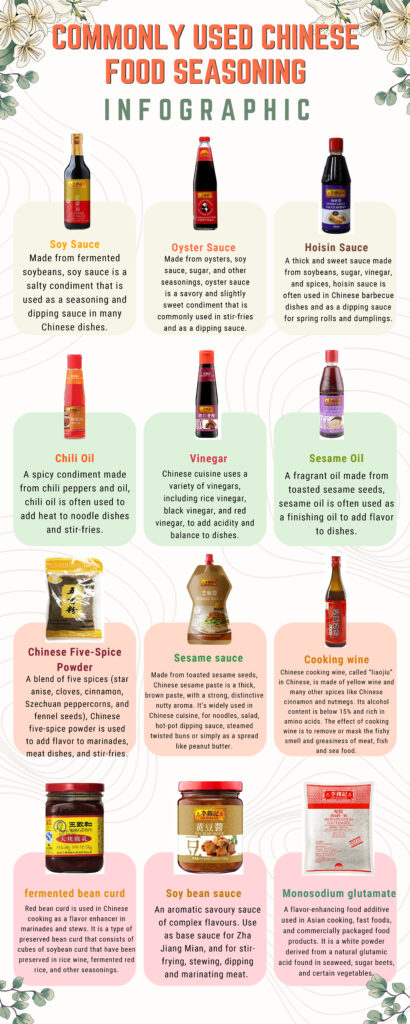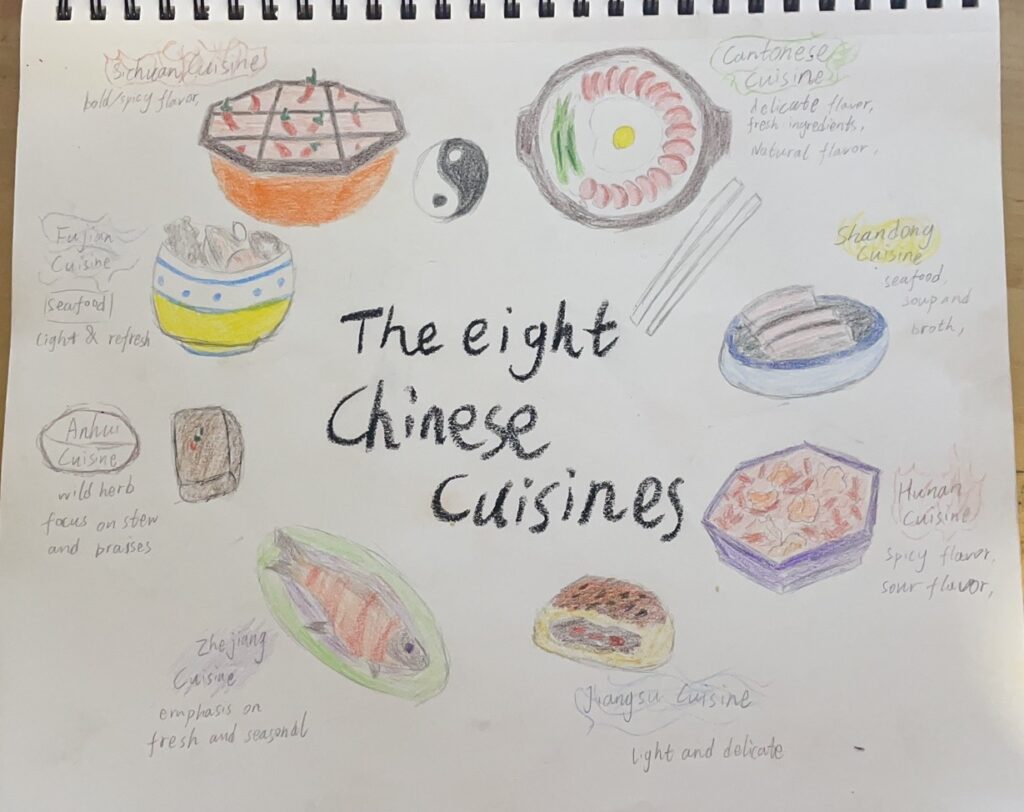Group H members:
- Disheng Zhang
- Edward Yan
- Tiancheng Zhang
- Zhengqiao Zhong
Overview
This course mainly introduces:
- The history of Chinese cuisine. Knowledge of different cuisines and the history of Chinese food will enable you to create not only delicious food but also an appreciation for the history and culture that the cuisine represents.
- Various Chinese seasonings. Understanding commonly used Chinese food seasonings is crucial for the study of future courses. Different Chinese dishes require different seasoning combinations to create the most delicious food possible. Without understanding various seasonings, it is almost impossible to create tasty Chinese cuisine.
- How to make a Chinese dish on your own. Learning how to make Chinese cuisine by hand can give you an understanding of the cooking methods that are drastically different from those of other cuisines. Chinese cuisine does not have strict requirements for the amount of seasoning used but rather allows for a lot of flexibility to suit individual tastes. Completing this process will also make you more adept in subsequent learning.
Lesson Objectives
By the end of this class you will be able to:
- Understand the history of Chinese cuisine.
- Identify common Chinese seasonings and understand their use.
- Independently prepare a taught Chinese food.
Read/Watch
Chinese Food 101: North vs. South vs. East vs. West – Eat China — (4 min) Some essential explanations about the food in different regions of China.
The 12 Must-Have Chinese Seasonings — (10 min) Some common condiments in Chinese cuisine are introduced.
The Five Major Cuisines of China — (9 min) The five most famous Chinese cuisines and their differences.
Content
Chinese cuisine uses a variety of condiments to enhance the flavors of dishes. Here are some common condiments used in Chinese cooking:

Chinese cuisine features:
Chinese cuisine is one of the world’s oldest and most diverse culinary traditions. It can be divided into the eight local cuisines of Hui, Guangdong, Fujian, Hunan, Jiangsu, Shandong, Sichuan, and Zhejiang. Each region has unique flavors and cooking techniques, but some general characteristics are common to Chinese cuisine.
- Flavor balance: Chinese cuisine pays great attention to achieving flavor balance. This involves balancing sweet, sour, bitter, spicy, and salty flavors to create harmonious flavors.
- Use fresh ingredients: Chinese cooking often uses fresh ingredients such as vegetables, meat, seafood, and herbs. However, using seasonal ingredients is also essential in Chinese cuisine.
- Cooking techniques: Chinese cuisine adopts various cooking techniques, such as stir-frying, steaming, braising, boiling, and deep-frying. Each technique is used to bring out the taste and texture of the ingredients.
- The importance of color: Chinese cuisine attaches great importance to the color of dishes. The use of different colors not only enhances the visual appeal of dishes but also represents different flavors and nutritional values.
- Use of sauces and seasonings: Chinese cuisine uses a variety of spices and seasonings to enhance the flavor of dishes. These include soy, oyster, hoisin, and Chinese five-spice powder.
- Health benefits: Chinese food is known for its health benefits. Many dishes contain ingredients believed to have medicinal properties and can be used to prevent or treat disease.
Introduction to Eight Chinese Cuisines:

What should be paid attention to when making Chinese dishes?
When making Chinese food, there are a few things to pay attention to:
- Preparation: Chinese food usually requires a lot of preparation, including shredding, marinating, and blanching. Make sure you have all your ingredients ready before you start cooking.
- Heat control: Chinese cooking usually requires high temperatures, so being able to control the heat of the stove or wok is very important. Preheat the wok or pan before adding ingredients, and adjust the heat as needed to prevent burning or overcooking.
- Balance of taste: Chinese food pays great attention to the balance of flavor. Pay attention to the dish’s sweet, sour, salty, and savory ratio to ensure a harmonious taste.
- Timing: Many Chinese dishes are prepared quickly, so timing is essential. Before you begin cooking, ensure all the ingredients are ready and pay attention to the cooking time to avoid overcooking or undercooking.
- Texture: Chinese cuisine also emphasizes achieving a variety of textures in dishes, such as crispness, softness, or chewability. Pay attention to cooking methods and the order in which ingredients are added to achieve the desired texture.
- Visual: Chinese cuisine usually consists of colorful and visually appealing dishes. Pay attention to the presentation of dishes, including the arrangement of ingredients and garnishes.
Make a Chinese cuisine dish by yourself
We will explain to you how to make a famous Chinese dish—-Kung Pao Chicken, by yourself.
Reflection Question
These questions are designed to inspire you to think about this lesson. Choose one or more issues that interest you and comment on them.
- What do you think are the characteristics of Chinese food in general? What are the differences from other cuisines?
- Which Chinese cuisine are you most interested in? What attracted you most to him?
- What problems do you encounter when trying to make a Chinese dish? What do you find different from other dishes?
- What don’t you know about Chinese seasonings? Which seasonings are you most interested in? Why?
To do this week
- Complete all reading/viewing activities and read all the material for this blog.
- Make a video of yourself making Chinese food and post it on your blog.
- Evaluate other people’s production videos.
Reference
Facebook.com/thewoksoflife. (2022, October 9). 8 Chinese cuisines & how they differ. The Woks of Life. Retrieved April 6, 2023, from https://thewoksoflife.com/8-chinese-cuisines/
The top 10 most common herbs and spices used to flavor Chinese food. (n.d.). Retrieved April 6, 2023, from https://www.chinahighlights.com/travelguide/chinese-food/herbs-and-spices.htm
Chinese food culture. (n.d.). Retrieved April 6, 2023, from https://www.chinadiscovery.com/chinese-food/food-culture.html
Chinese food culture. Chinese Food/Cuisine: Culture, Ingredients, Regional Flavors. (n.d.). Retrieved April 6, 2023, from https://www.chinahighlights.com/travelguide/chinese-food/
Theories and Principles
Infographic: I incorporated the principles of “Limit your color palette”, “Keep imagery simple” and “White space is a good thing” into my infographic on Chinese seasoning ingredients. By limiting the color combinations to several lighter colors, the infographic became easier to read and less confusing. Additionally, I used only a few simple images that were relevant to the content, as complex images can distract from the main message. I also made sure to leave ample white space, as an infographic that is completely filled with content can be overwhelming and uninteresting. These design principles helped me create an effective and visually pleasing infographic.
Sketchnote: About Sketchnote, I Segment Chinese cuisine with painting to simplify it. And add a few words to explain the characteristics of each significant cuisine to facilitate understanding.
Final Project Plan

Leave a Reply
You must be logged in to post a comment.